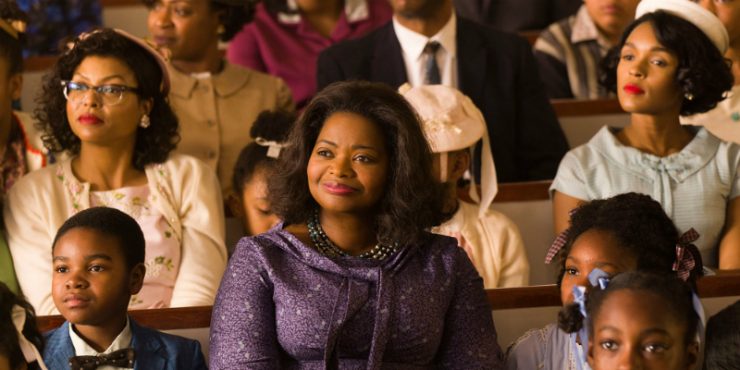Hidden Figures is a cinematic exercise in sincere good-heartedness. It’s a film that wants to be about race but never wants to risk actually challenging the racial dynamics of its audience. It’s safe and is orchestrated to make everybody leave feeling content with the sweet utopia of the world. The film is loosely based on the careers of three black women who found themselves front and center in the space race of the 1960’s. You can tell just by the film’s first act that the movie is playing fast and loose with historical accuracy, with characters speaking dialogue which project on-the-nose witticisms. Taraji P. Henson plays Katherine Goble, a childhood wunderkind who was accomplishing advanced math by the sixth grade. Decades later, a widow with three daughters, Katherine works as a computer at NASA (in a pre-IBM universe, computers was a designation for women who, you know, computed). She rides to work daily with Dorothy Vaughn (Octavia Spencer) and Mary Jackson (Janelle Monáe), and all three women work in the West Area computers division.
Though it sounds like its divided geographically, its actually segregated racially. The West computers are all black, while the East computers, headed by Vivian Mitchell (Kirsten Dunst), are all white. When the supervisor for the West computers retired, Dorothy took up the slack without an uptick in pay or a promotion in title, a professional plateau that Vivian works toward making a permanent reality. As for Mary, she’s an engineer with two degrees who can’t rise above computing, because of the double whammy of being black and a woman. For Katherine, she meets her greatest brush with prejudice after getting a promotion to computer for Al Harrison (Kevin Costner), director of the Space Task Group. Katherine’s job is to check the numbers of Paul Stafford (Jim Parsons), a NASA engineer who immediately takes issue with having his work checked by a black woman. Citing Katherine’s lack of clearance for the more sensitive information, Paul uses a magic marker to redact pertinent information that could help Katherine do her job. With the USSR launching a man into orbit, the Space Race between Americans and the Soviets kicks into high gear and with Cold War paranoia raging, American citizens wait desperately for the US to catch up in their attempts to conquer the sky. Yet, many white engineers continue to prolong the process by burdening Kathrine’s position.
Kevin Costner’s Al Harrison is a harsh, but soft-spoken man who chews a lot of gum and does little in the way of sympathizing with his employees’ workload. Hidden Figures should get credit for making a film about black women and telling their story from their point-of-view, but despite this, it still plays into the all-too-common American cinematic trope of the white savior. Costner’s Harrison is the kind of character that we’ve seen a million times: a principled white man who may not be racially conscious but he is color blind. When he learns that his engineers have brought in a separate coffee pot for Katherine and threw a “colored” sticker on it, he acts as if the entire concept baffles him. When he learns that Katherine must walk half a mile to use the colored bathroom in the West Computers division, he takes a crowbar and rips the “colored” sign out of the wall and declares bathroom equality. Hidden Figures is about the triumph of black women in a world dominated by white men, but the film still stands in awe of these white men – even the racist ones, we admire their ability to put aside their prejudice for the good of the job. As if, despite the pervasiveness of race in America, deep down everything really is a meritocracy.
The film is directed by Theodore Melfi, whose only previous feature film credit is 2014’s St. Vincent, one of those bittersweet Bill Murray comedies that’s charming enough, but wouldn’t suggest much at all that the filmmaker is equipped to tackle a racially-charged narrative. Casting Henson, Spencer and Monáe is the film’s godsend. The three actresses, in such independently striking ways portray strength and perseverance in the face of oppression. Monáe, a successful model and Grammy-nominated recording artist, has added actress to her resume, after this film and another tremendous performance in Barry Jenkins’ Moonlight in October, she’s proving to be a force on the screen. Oscar-winner Octavia Spencer is strong as well, a continuation of what has been a strong post-Oscar career – she’s proven incredibly intelligent in not allowing herself to be typecast, picking interesting roles and films for the past five years. But Figures is a showcase for Henson, the film and television veteran who has worked for close to fifteen years, and this is his her first opportunity to open a film as the star. Henson has always been a star, and its good to see Hollywood finally treating her like one (they’re trailing television, where she’s already royalty for her performance on Empire). Hidden Figures is deserving of her screen presence and she follows through with a great performance that is only slightly undermined by the elementary screenplay.
It’s refreshing to see a historical film about three black women, but it’s hard to watch Hidden Figures and not get the sense that it is another American film about race constructed to make sure whites are not offended. In the end, it is still a film about a white person’s capacity to change and overcome their own human flaws. Katherine, Mary and Dorothy are just subject to their whims. The performances from Henson, Monáe and Spencer are worth seeing, and that alone pulls Figures above the heavy-handed Hollywood tradition of soft-soaped racial politics. There is a real affection that Melfi’s film has for these women, and there’s a reason that attention is paid to the fact that all three of them have families that they’re expected to take after. Its heart is in the best of places, but its priorities are in pleasing white audiences. I quite enjoyed this film, particularly its second half where all the obvious place settings of the first half pay off in satisfying fashion. It’s a movie made to make you leave the theater happy with the state of humanity, content that past misdeeds will not repeat themselves. Its hard not to let that kind of storytelling make you queasy these days, but Hidden Figures gives it a good effort.
Directed by Theodore Melfi










